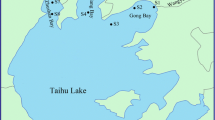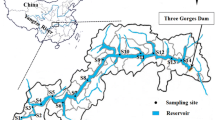Abstract
The occurrence and estrogenic activities of steroid estrogens, such as the natural estrone (E1), 17β estradiol (E2), and estriol (E3), as well as the synthetic 17α-ethynylestradiol (EE2), were investigated in eight sampling points along the Langat River (Malaysia). Surface water samples were collected at 0.5 m and surface sediment 0–5 cm from the river surface. Instrument analysis of steroid estrogens was determined by UPLC-ESI-MS with an ultra-performance liquid chromatograph (Perkin Elmer FX15) coupled to a Q Trap function mass spectrophotometer (model 3200: AB Sciex). Steroid estrogen concentrations were higher in the Langat River sediments than those in its surface water. In surface water, E1 was not detected in any sampling point, E2 was only detected in two midstream sampling points (range 0–0.004 ng/L), E3 in three sampling points (range 0–0.002 ng/L), and EE2 in four sampling points (range 0–0.02 ng/L). E1 and E2 were detected in sediments from all sampling points, E3 in five sampling points, while EE2 only in one midstream sample (3.29E−4 ng/g). Sewage treatment plants, farming waste, and agricultural activities particularly present midstream and downstream were identified as potential sources of estrogens. Estrogenic activity expressed as estradiol equivalents (EEQs) was below 1 ng/L in all samples for both surface water and sediment, indicating therefore a low potential estrogenic risk to the aquatic environment. Although the health risks are still uncertain for drinking water consumers exposed to low levels of steroid estrogen concentrations, Langat River water is unacceptable for direct drinking purposes without treatment. Further studies of endocrine disruptors in Malaysian waters are highly recommended.



Similar content being viewed by others
References
Abbasi Tarighat, M. (2014). Extraction of the contribution of kinetic profile for reaction of a chemical species in unknown matrices by standard addition method. Arabian Journal of Chemistry. doi:10.1016/j.arabjc.2014.11.042.
Aftafa, C., Pelit, F. O., Yalcinkaya, E. E., Turkmen, H., Kapdan, I., & Ertas, F. N. (2014). Ionic liquid intercalated clay sorbents for micro solid phase extraction of steroid hormones from water samples with analysis by liquid chromatography–tandem mass spectrometry. Journal of Chromatography, 1361, 43–52.
Al-Odaini, N. A., Zakaria, M. P., Yaziz, M. I., Surif, S., & Kannan, N. (2013). Occurrence of synthetic hormones in sewage effluents and Langat River and its tributaries, Malaysia. International Journal of Environmental Analytical Chemistry, 93(14), 1457–1469. doi:10.1080/03067319.2012.727810.
Aris, A. Z., Shamsuddin, A. S., & Praveena, S. M. (2014). Occurrence of 17α-ethynylestradiol (EE2) in the environment and effect on exposed biota: a review. Environment International, 69, 104–119. doi:10.1016/j.envint.2014.04.011.
Azrina, M. Z., Yap, C. K., Rahim Ismail, A., Ismail, A., & Tan, S. G. (2006). Anthropogenic impacts on the distribution and biodiversity of benthic macroinvertebrates and water quality of the Langat River, Peninsular Malaysia. Ecotoxicology and environmental safety, 64(3), 337–47. doi:10.1016/j.ecoenv.2005.04.003.
Barel-Cohen, K., Shore, L. S., Shemesh, M., Wenzel, A., Mueller, J., & Kronfeld-Schor, N. (2006). Monitoring of natural and synthetic hormones in a polluted river. Journal of Environmental Management, 78(1), 16–23. doi:10.1016/j.jenvman.2005.04.006.
Baronti, C., Curini, R., D’Ascenzo, G., Di Corcia, A., Gentili, A., & Samperi, R. (2000). Monitoring natural and synthetic estrogens at activated sludge sewage treatment plants and in a receiving river water. Environmental Science and Technology, 34(24), 5059–5066. doi:10.1021/es001359q.
Braga, O., Smythe, G. A., Schafer, A. I., & Feitz, A. J. (2005). Steroid estrogens in ocean sediments. Chemosphere, 61, 827–833.
Céspedes, R., Petrovic, M., Raldúa, D., Saura, Ú., Piña, B., Lacorte, S., Viana, P., & Barcelo, D. (2004). Integrated procedure for determination of endocrine-disrupting activity in surface waters and sediments by use of the biological technique recombinant yeast assay and chemical analysis by LC-ESI-MS. Analytical and Bioanalytical Chemistry, 378(3), 697–708. doi:10.1007/s00216-003-2303-5.
Chang, H. S., Choo, K. H., Lee, B., & Choi, S. J. (2009). The methods of identification, analysis, and removal of endocrine disrupting compounds (EDCs) in water. Journal of Hazardous Materials, 172(1), 1–12. doi:10.1016/j.jhazmat.2009.06.135.
Colborn, T., Vom Saal, F. S., & Soto, A. M. (1993). Developmental effects of endocrine-disrupting chemicals in wildlife and humans. Environmental Health Perspectives, 101(5), 378–384. doi:10.1289/ehp.93101378.
Danzer, K., & Currie, L. A. (1998). Guidelines for calibration in analytical chemistry. Part I. Fundamentals and single component calibration (IUPAC Recommendations 1998). Pure and Applied Chemistry, 70(4), 993–1014. doi:10.1351/pac199870040993.
Department of Environment of Malaysia. (2009). Malaysia Environmental Quality Report 2009. Putrajaya: Department of Environment, Ministry of Natural Resources and Environment.
Esteban, S., Gorga, M., Petrovic, M., González-Alonso, S., Barceló, D., & Valcárcel, Y. (2014). Analysis and occurrence of endocrine-disrupting compounds and estrogenic activity in the surface waters of Central Spain. Science of the Total Environment, 466–467, 939–951. doi:10.1016/j.scitotenv.2013.07.101.
Gorga, M., Insa, S., Petrovic, M., & Barcelo, D. (2014). Occurrence and spatial distribution of EDCs and related compounds in waters and sediments of Iberian rivers. Science of the Total Environment, 503–504, 69–86. doi:10.1016/j.scitotenv.2014.06.037.
Hamdy, D. A., & Belal, T. S. (2014). A Comparative Study of Newly Developed HPLC-DAD and UHPLC-UV Assays for the Determination of Posaconazole in Bulk Powder and Suspension Dosage Form. Journal of Analytical Methods in Chemistry. doi:10.1155/2014/241035.
Huang, B., Wang, B., Ren, D., Jin, W., Liu, J., Peng, J., & Pan, X. (2013). Occurrence, removal and bioaccumulation of steroid estrogens in Dianchi Lake catchment, China. Environment International, 59, 262–273. doi:10.1016/j.envint.2013.06.018.
Isobe, T., Serizawa, S., Horiguchi, T., Shibata, Y., Managaki, S., Takada, H., Morita, M., & Shiraishi, H. (2006). Horizontal distribution of steroid estrogens in surface sediments in Tokyo Bay. Environmental Pollution, 144(2), 632–638. doi:10.1016/j.envpol.2006.01.030.
Juahir, H., Zain, S. M., Yusoff, M. K., Hanidza, T. I., Armi, A. S., Toriman, M. E., & Mokhtar, M. (2011). Spatial water quality assessment of Langat River Basin (Malaysia) using environmetric techniques. Environmental monitoring and assessment, 173(1–4), 625–41. doi:10.1007/s10661-010-1411-x.
Jürgens, M. D., Williams, R. J., & Johnson, A. C. (1999). Fate and behaviour of steroid oestrogens in rivers: a scoping study (Natural Environment Research Council). Briston: Environment Agency.
Koh, Y. K. K., Chiu, T. Y., Boobis, A., Cartmell, E., Lester, J. N., & Scrimshaw, M. D. (2007). Determination of steroid estrogens in wastewater by high performance liquid chromatography-tandem mass spectrometry. Journal of Chromatography A, 1173(1–2), 81–87. doi:10.1016/j.chroma.2007.09.074.
Kolodziej, E. P., Gray, J. L., & Sedlak, D. L. (2003). Quantification of steroid hormones with pheromonal properties in municipal wastewater effluent. Environmental toxicology and chemistry/SETAC, 22(11), 2622–2629. doi:10.1897/03-42.
Kuster, M., José López De Alda, M., & Barceló, D. (2004). Analysis and distribution of estrogens and progestogens in sewage sludge, soils and sediments. Trends in Analytical Chemistry, 23(10–11), 790–798. doi:10.1016/j.trac.2004.08.007.
Laganà, A., Bacaloni, A., De Leva, I., Faberi, A., Fago, G., & Marino, A. (2004). Analytical methodologies for determining the occurrence of endocrine disrupting chemicals in sewage treatment plants and natural waters. Analytica Chimica Acta, 501(1), 79–88. doi:10.1016/j.aca.2003.09.020.
Lai, K. M., Johnson, K. L., Scrimshaw, M. D., & Lester, J. N. (2000). Binding of waterborne steroid estrogens to solid phases in river and estuarine systems. Environmental Science and Technology, 34(18), 3890–3894. doi:10.1021/es9912729.
Law, A. T., Shazili, N. A., Yaacob, R., Chark, L. H., Saadon, M. S., & Shamsudin, L. (1991). Coastal oceanography studies in the Straits of Malacca and South China Sea. Pulau Pinang, Malaysia.
Lee, L. S., Carmosini, N., Sassman, S. A., Dion, H. M., & Sepúlveda, M. S. (2007). Agricultural contributions of antimicrobials and hormones on soil and water quality. Advances in Agronomy, 93, 1–68. doi:10.1016/S0065-2113(06)93001-6.
Lim, W. Y., Aris, A. Z., & Ismail, T. H. T. (2013a). Spatial geochemical distribution and sources of heavy metals in the sediment of Langat River, western peninsular Malaysia. Environmental Forensics, 14(2), 133–145. doi:10.1080/15275922.2013.781078.
Lim, W. Y., Aris, A. Z., Ismail, T. H. T., & Zakaria, M. P. (2013b). Elemental hydrochemistry assessment on its variation and quality status in Langat River, Western Peninsular Malaysia. Environmental Earth Sciences, 70(3), 993–1004. doi:10.1007/s12665-012-2189-7.
López de Alda, M. J., Gil, A., Paz, E., & Barceló, D. (2002). Occurrence and analysis of estrogens and progestogens in river sediments by liquid chromatography-electrospray-mass spectrometry. Analyst, 127, 1299–304.
Nováková, L., Matysová, L., & Solich, P. (2006). Advantages of application of UPLC in pharmaceutical analysis. Talanta, 68(3), 908–918. doi:10.1016/j.talanta.2005.06.035.
Peck, M., Gibson, R. W., Kortenkamp, A., & Hill, E. M. (2004). Sediments are major sinks of steroidal estrogens in two United Kingdom rivers. Environmental toxicology and chemistry/SETAC, 23(4), 945–952. doi:10.1897/03-41.
Peng, X., Wang, Z., Yang, C., Chen, F., & Mai, B. (2006). Simultaneous determination of endocrine-disrupting phenols and steroid estrogens in sediment by gas chromatography–mass spectrometry. Journal of Chromatography A, 1116(1–2), 51–56. doi:10.1016/j.chroma.2006.03.017.
Praveena, S. M., Kwan, O. W., & Aris, A. Z. (2012). Effect of data pre-treatment procedures on principal component analysis: a case study for mangrove surface sediment datasets. Environmental Monitoring and Assessment, 184(11), 6855–6868. doi:10.1007/s10661-011-2463-2.
Rao, K., Lei, B., Li, N., Ma, M., & Wang, Z. (2013). Determination of estrogens and estrogenic activities in water from three rivers in Tianjin, China. Journal of Environmental Sciences (China), 25(6), 1164–1171. doi:10.1016/S1001-0742(12)60149-1.
Sarmani, S. B. (1989). The determination of heavy metals in water, suspended materials and sediments from Langat River, Malaysia. Hydrobiologia, 176–177(1), 233–238. doi:10.1007/BF00026558.
Shi, W., Zhang, F.-X., Hu, G.-J., Hao, Y.-Q., Zhang, X.-W., Liu, H.-L., Wei, S., Wang, X.-R., Giesy, J. P., & Yu, H.-X. (2012). Thyroid hormone disrupting activities associated with phthalate esters in water sources from Yangtze River Delta. Environment International, 42, 117–123. doi:10.1016/j.envint.2011.05.013.
Sodré, F. F., Locatelli, M. A. F., & Jardim, W. F. (2010). Occurrence of emerging contaminants in Brazilian drinking waters: a sewage-to-tap issue. Water Air Soil Pollution, 206, 57–67.
Ternes, T. A., Stumpf, M., Mueller, J., Haberer, K., Wilken, R. D., & Servos, M. (1999). Behavior and occurrence of estrogens in municipal sewage treatment plants - I. Investigations in Germany, Canada and Brazil. Science of the Total Environment, 225(1–2), 81–90. doi:10.1016/S0048-9697(98)00334-9.
Ternes, T. A., Andersen, H., Gilberg, D., & Bonerz, M. (2002). Determination of estrogens in sludge and sediments by liquid extraction and GC/MS/MS. Analytical Chemistry, 74(14), 3498–3504. doi:10.1021/ac015717z.
Wang, L.-S., Wang, L., Wang, L., Wang, G., Li, Z.-H., & Wang, J.-J. (2009). Effect of 1-butyl-3-methylimidazolium tetrafluoroborate on the wheat (Triticum aestivum L.) seedlings. Environmental Toxicology, 24(3), 296–303. doi:10.1002/tox.
Wang, H. X., Zhou, Y., & Jiang, Q. W. (2012). Simultaneous screening of estrogens, progestogens, and phenols and their metabolites in potable water and river water by ultra-performance liquid chromatography coupled with quadrupole time-of-flight mass spectrometry. Microchemical Journal, 100(1), 83–94. doi:10.1016/j.microc.2011.09.010.
Yusoff, I., Rahim, S. A., Wan, W. Y., Ghani, M. R. A., Lumpur, K., & Sciences, N. R. (2008). Heavy metal contamination of soil beneath a waste disposal site at Dengkil, Selangor, Malaysia. Soil and Sediment Contamination, 17(5), 449–466. doi:10.1080/15320380802304342.
Zhang, X., Gao, Y., Li, Q., Li, G., Guo, Q., & Yan, C. (2011). Estrogenic compounds and estrogenicity in surface water, sediments, and organisms from Yundang Lagoon in Xiamen, China. Archives of Environmental Contamination and Toxicology, 61(1), 93–100. doi:10.1007/s00244-010-9588-0.
Zhang, Z., Ren, N., Kannan, K., Nan, J., Liu, L., Ma, W., Hongli, Q., & Yifan, L. (2014). Occurrence of endocrine-disrupting phenols and estrogens in water and sediment of the Songhua River, Northeastern China. Archives of Environmental Contamination and Toxicology, 66(3), 361–369. doi:10.1007/s00244-014-9998-5.
Zhao, J.-L., Ying, G.-G., Chen, F., Liu, Y.-S., Wang, L., Yang, B., Shan, L., & Ran, T. (2011). Estrogenic activity profiles and risks in surface waters and sediments of the Pearl River system in South China assessed by chemical analysis and in vitro bioassay. Journal of Environmental Monitoring, 13(4), 813–821. doi:10.1039/c0em00473a.
Acknowledgments
The authors would like to thank the Kurita Water Research Grant (Japan) vote number 6385300 and Pure Earth for their financial support.
Author information
Authors and Affiliations
Corresponding author
Rights and permissions
About this article
Cite this article
Praveena, S.M., Lui, T.S., Hamin, N. et al. Occurrence of selected estrogenic compounds and estrogenic activity in surface water and sediment of Langat River (Malaysia). Environ Monit Assess 188, 442 (2016). https://doi.org/10.1007/s10661-016-5438-5
Received:
Accepted:
Published:
DOI: https://doi.org/10.1007/s10661-016-5438-5




